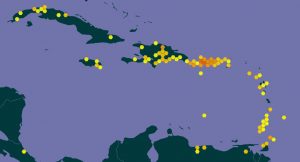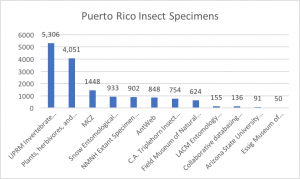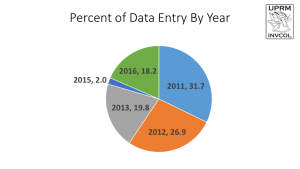About the Collection
Overview of Holdings and Outreach Guided Tours
Outreach Guided Tours
The UPRM-INVCOL is the primary repository for invertebrate reference specimens in western Puerto Rico. We are open to the public, and have guided tours for school groups by appointment. If your school can not make it here to Mayaguez we will also come to you. If you would like a guided tutorial about our collection please send Dr. Van Dam an e-mail to make arrangements to have us bring the insects to you.
Overview of Holdings
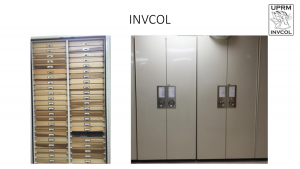
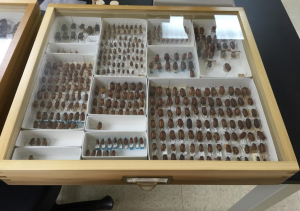
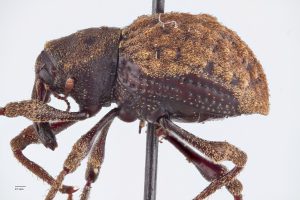
For full access to the databased specimens and breakdown of our holdings please visit our sites, INVCOL on iDigBio & INVCOL on GBIF
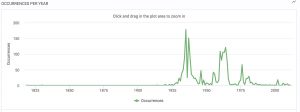
The holdings of UPRM-INVCOL generally overlap with those of the Museo de Entomología y Biodiversidad Tropical in Río Piedras, with a more pronounced geographic emphasis on southwestern Puerto Rico, including the regions around Mayagüez and Ponce. All 26 Puerto Rican orders are represented (see Maldonado Capriles 1996), including obscure groups such as Protura and Zoraptera. The collection harbors some of the earliest records of insects from ecologically valuable areas such as Guánica, Maricao, and Mona Island including specimens from José Ramos’ (1946) pioneering survey. The holdings are particularly strong in Neotropical Collembola, corresponding to the José Mari Mutt collection. The taxonomic coverage for these groups is very thorough thanks to extensive personal collections throughout the Caribbean in the 1930s to 1970s (primarily Puerto Rico, Dominican Republic, and Jamaica), exchanges with colleagues, and purchasing of specimens from South America (primarily Colombia, Venezuela, Argentina, and Chile). Both the Puerto Rican Coleoptera and Diptera are well represented and identified. The Hymenoptera, on the other hand, are lacking in the parasitoid lineages. Finally, the Lepidoptera holdings are strongest in the Puerto Rican butterflies is also quite good. All total we have around 52,000 specimens many of which are of historical importance.
Regarding the non-hexapods, the valuable mollusks shell collection assembled by Carlos Aguayo contains nearly 9500 catalogued specimens. It is notable for its strong representation of species in the genus Cerion Roding (Gastropoda: Ceriidae) from the Antilles. There are also approximately 1230 specimens of Crustacea. Data of holdings of non-hexapod type specimens are not available at this time. The holdings of UPRM-INVCOL are presently increasing at an annual pace of 2-5k specimens. Researchers interested in particular taxa should Contact Us with their inquiries.
Our Collection Holds Unique Specimens Found No Where Else:
There is shockingly little overlap with the databased specimens found on iDIgBIo and GBIF and mainland US collections. This may change as more specimens from Puerto Rico get digitized through our iDigIslands working group, but it demonstrates the importance of this collection to the global entomological community. Comparing the unique scientific names deposited by INVCOL and all other major collections on GBIF, there is only a 20% overlap (177 overlap / 903 UPRM species).
UPRM INVCOL Is an Active Collection:
We increased the museum database holding in our first year of re-opening by more than 18% in 2016. We did this with zero funding, all just hard work by our undergraduates. In 2017 we had to dial back those efforts to finish moving the collection to the Entomology Laboratory Building. Hurricane Maria also happened in 2017. It was good that we moved the collection about six months prior to Maria as we used power from the campus Guardia building to power our split type AC’s that saved the collection. We also acquired funding in 2017 to build our new molecular lab from a NIH PR-INBRE grant and a USDA-NIFA HSI Grant. In 2018 we have been busy barcoding specimens to get all caught up before our new rapid digitization systems get here ahead of the meta-barcoding project funded by the USDA-NIFA HSI Grant awarded to Dr. Van Dam.
Specimen Loans:
Museums are like libraries in that we loan specimens to scientific researchers who need to view specific specimens at their institution or university found in our collection. For example when a researcher at another university doesn’t have a specific insect species but we do, that research may request a loan to have us send them specimens. Below are our loan policies for researchers wishing to have us loan them specimens.
Loan Policy:
Loan requests for should be directed to Dr. Alex Van Dam (alex.vandam@upr.edu). Conditions and practices regarding loans from the UPRM Invertebrate Collection (INVCOL), hereafter referred to as “the Collection”, as understood and agreed to by recipients thereof:
-
When materials are received by borrowers, the duplicate loan invoice (enclosed with the specimens) should be signed and returned immediately to the Collection. Each loan is given a unique number, to be used in all correspondence referring to the loan.
-
Loans are made for a stipulated period of time, typically 3 months and must be renewed every three months, and may be extended in appropriate circumstances upon written application to and approval by the Collection (No specimens should be returned during December). The Collection reserves the right to recall any of its material at any time. Loans are not transferable and may not be relocated without approval from the Collection. The loan policy of 3 months is due to past loans not being returned.
-
Borrowers should not assume that they can retain any specimens unless prior permission is obtained, though permission is usually granted upon request. Primary types should always be returned unless specifically exempted. If the borrower has all of the Collection’s holdings of a given higher taxon, then we request the return of all uniques, at least one specimen of each sex, caste, or major variant for each species represented, and, if possible, one specimen from each discrete locality (i.e., specimens retained should be duplicates in all possible respects).
-
If the borrower has in mind a specific repository other than the Collection, then this should be communicated to and agreed upon by the Collection in advance. Otherwise, types designated from our material should be returned – preferably by registered mail – to the Collection as soon as convenient.
-
If specimens to be retained permanently have a UPRM database number label, and the retaining institution wishes to assign their own database label, the UPRM label should be removed and returned to the Collection. Note that most specimens bearing UPRM database labels have associated data that does not appear on the specimen labels (e.g., georeference data), so we strongly advise against this; we likewise request that any publications citing data from, or mapping such specimens, use the data from the UPRM database, rather than verbatim citation of the label data, which may be incomplete or erroneous.
-
Borrowers who wish to dissect any specimen are required to do so in such a way that the specimen suffers the least possible damage, and must ensure that parts dissected out are correctly preserved and associated with the rest of the specimen. DNA sampling is allowed, but we request that non-destructive techniques be used (e.g., only a tarsus, or at most a leg). Specimens completely destroyed in order to do genetic analysis are considered as “gifts”, but sequence data should be returned to the Collection in some form (publication or otherwise).
-
Borrowers should attach determination labels to every non-databased specimen returned or, if this is impractical, the material returned should be arranged to show clearly to which specimens a given determination applies. If the borrower has been sent a specimen-level databased inventory, the Collection should be given a duplicate of the edited database file to incorporate into the Collection’s primary database.
-
Acknowledgment in any paper resulting from the study of materials borrowed from the Collection would be appreciated as well as a reprint(s) of such paper(s).
-
Additional special conditions may apply on an individual basis.
